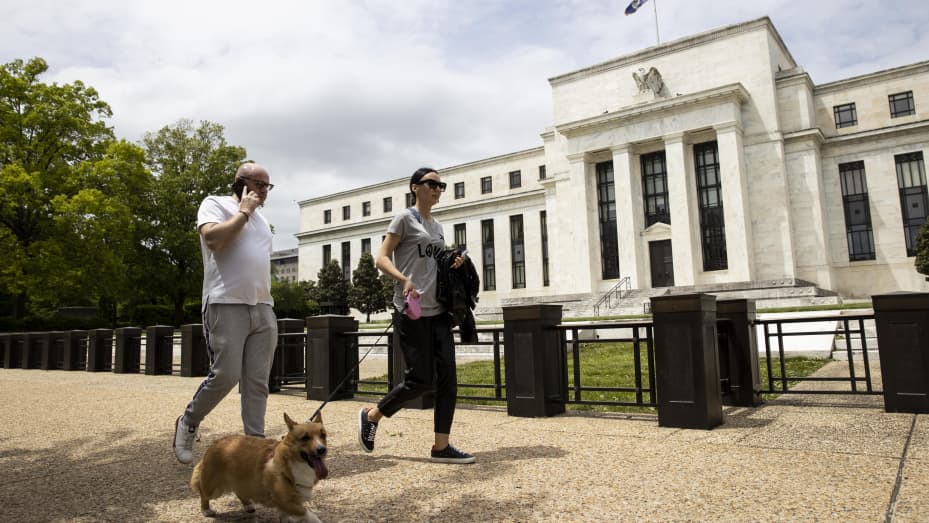Economy
What’s new with the U.S. Fed’s 2023 bank stress tests?

The U.S. Federal Reserve is due to release the results of its annual bank health checks on Wednesday, June 28. Under the “stress test” exercise, the Fed tests banks’ balance sheets against a hypothetical severe economic downturn, the elements of which change annually.
The results dictate how much capital banks need to be healthy and how much they can return to shareholders via share buybacks and dividends.
WHY DOES THE FED “STRESS TEST” BANKS?
The Fed established the tests following the 2007-2009 financial crisis as a tool to ensure banks could withstand a similar shock in future. The tests formally began in 2011, and large lenders initially struggled to earn passing grades.
Citigroup, Bank of America, JPMorgan Chase & Co and Goldman Sachs Group, for example, had to adjust their capital plans to address the Fed’s concerns. Deutsche Bank’s U.S. subsidiary failed in 2015, 2016 and 2018.
However, years of practice have made banks more adept at the tests and the Fed also has made the tests more transparent. It ended much of the drama of the tests by scrapping the “pass-fail” model and introducing a more nuanced, bank-specific capital regime.
SO HOW ARE BANKS ASSESSED NOW?
The test assesses whether banks would stay above the required 4.5% minimum capital ratio during the hypothetical downturn. Banks that perform strongly typically stay well above that. The nation’s largest global banks also must hold an additional “G-SIB surcharge” of at least 1%.
How well a bank performs on the test also dictates the size of its “stress capital buffer,” an additional layer of capital introduced in 2020 which sits on top of the 4.5% minimum.
That extra cushion is determined by each bank’s hypothetical losses. The larger the losses, the larger the buffer.
THE ROLLOUT
The Fed will release the results after markets close. It typically publishes aggregate industry losses, and individual bank losses including details on how specific portfolios – like credit cards or mortgages – fared.
The Fed doesn’t allow banks to announce their plans for dividends and buybacks until typically a few days after the results. It announces the size of each bank’s stress capital buffer in the subsequent months.
The country’s largest lenders, particularly JPMorgan Citigroup, Wells Fargo & Co, Bank of America, Goldman Sachs, and Morgan Stanley are closely watched by the markets.
A TOUGHER TEST?
The Fed changes the scenarios each year. They take months to devise, which means they risk becoming outdated. In 2020, for example, the real economic crash caused by the COVID-19 pandemic was by many measures more severe than the Fed’s scenario that year.
The 2023 tests were devised before this year’s banking crisis in which Silicon Valley Bank and two other lenders failed. They found themselves on the wrong end of Fed interest rate hikes, suffering large unrealized losses on their U.S. Treasury bond holdings which spooked uninsured depositors.
The Fed has come under criticism for not having tested bank balance sheets against a rising interest rate environment, instead assuming rates would fall amid a severe recession.
Still, the 2023 test is expected to be more difficult than in previous years because the actual economic baseline is healthier. That means spikes in unemployment and drops in the size of the economy under the test are felt more acutely.
For example, the 2022 stress test envisioned a 5.8 percentage point jump in unemployment under a “severely adverse” scenario. In 2023, that increase is 6.5 percentage points, thanks to rising employment over the past year.
As a result, analysts expect banks will be told to set aside slightly more capital than in 2022 to account for expected growth in modeled losses.
STRESSES IN COMMERCIAL REAL ESTATE, CORPORATE DEBT
The exam also envisages a 40% slump in the prices of commercial real estate, an area of greater concern this year as lingering pandemic-era office vacancies stress borrowers.
In addition, banks with large trading operations will be tested against a “global market shock,” and some will also be tested against the failure of their largest counterparty.
For the first time, the Fed will also conduct an extra “exploratory market shock” against the eight largest and most complex firms, which will be another severe downturn but with slightly different characteristics.
This extra test will not count towards banks’ capital requirements, but will allow the Fed to explore applying multiple adverse scenarios in future. Fed Vice Chair for Supervision Michael Barr has said multiple scenarios could make the tests better at detecting banks’ weaknesses.
WHICH FIRMS ARE TESTED?
In 2023, 23 banks will be tested. That’s down from 34 banks in 2022, as the Fed decided in 2019 to allow banks with between $100 billion and $250 billion in assets to be tested every other year.
Economy
Russian central bank says it needs months to make sure CPI falling before rate cuts -RBC


© Reuters. Russian Central Bank Governor Elvira Nabiullina attends a news conference in Moscow, Russia June 14, 2019. REUTERS/Shamil Zhumatov/File Photo
MOSCOW (Reuters) – Russia’s central bank will need two to three months to make sure that inflation is steadily declining before taking any decision on interest rate cuts, the bank’s governor Elvira Nabiullina told RBC media on Sunday.
The central bank raised its key interest rate by 100 basis points to 16% earlier in December, hiking for the fifth consecutive meeting in response to stubborn inflation, and suggested that its tightening cycle was nearly over.
Nabiullina said it was not yet clear when exactly the regulator would start cutting rates, however.
“We really need to make sure that inflation is steadily decreasing, that these are not one-off factors that can affect the rate of price growth in a particular month,” she said.
Nabiullina said the bank was taking into account a wide range of indicators but primarily those that “characterize the stability of inflation”.
“This will take two or three months or more – it depends on how much the wide range of indicators that characterize sustainable inflation declines,” she said.
The bank will next convene to set its benchmark rate on Feb. 16.
The governor also said the bank should have started monetary policy tightening earlier than in July, when it embarked on the rate-hiking cycle.
Economy
China identifies second set of projects in $140 billion spending plan


© Reuters. FILE PHOTO: Workers walk past an under-construction area with completed office towers in the background, in Shenzhen’s Qianhai new district, Guangdong province, China August 25, 2023. REUTERS/David Kirton/File Photo
SHANGHAI (Reuters) – China’s top planning body said on Saturday it had identified a second batch of public investment projects, including flood control and disaster relief programmes, under a bond issuance and investment plan announced in October to boost the economy.
With the latest tranche, China has now earmarked more than 800 billion yuan of its 1 trillion yuan ($140 billion) in additional government bond issuance in the fourth quarter, as it focuses on fiscal steps to shore up the flagging economy.
The National Development and Reform Commission (NDRC) said in a statement on Saturday it had identified 9,600 projects with planned investment of more than 560 billion yuan.
China’s economy, the world’s second largest, is struggling to regain its footing post-COVID-19 as policymakers grapple with tepid consumer demand, weak exports, falling foreign investment and a deepening real estate crisis.
The 1 trillion yuan in additional bond issuance will widen China’s 2023 budget deficit ratio to around 3.8 percent from 3 percent, the state-run Xinhua news agency has said.
“Construction of the projects will improve China’s flood control system, emergency response mechanism and disaster relief capabilities, and better protect people’s lives and property, so it is very significant,” the NDRC said.
The agency said it will coordinate with other government bodies to make sure that funds are allocated speedily for investment and that high standards of quality are maintained in project construction.
($1 = 7.1315 renminbi)
Economy
Russian central bank says it needs months to make sure CPI falling before rate cuts -RBC


© Reuters. Russian Central Bank Governor Elvira Nabiullina attends a news conference in Moscow, Russia June 14, 2019. REUTERS/Shamil Zhumatov/File Photo
MOSCOW (Reuters) – Russia’s central bank will need two to three months to make sure that inflation is steadily declining before taking any decision on interest rate cuts, the bank’s governor Elvira Nabiullina told RBC media on Sunday.
The central bank raised its key interest rate by 100 basis points to 16% earlier in December, hiking for the fifth consecutive meeting in response to stubborn inflation, and suggested that its tightening cycle was nearly over.
Nabiullina said it was not yet clear when exactly the regulator would start cutting rates, however.
“We really need to make sure that inflation is steadily decreasing, that these are not one-off factors that can affect the rate of price growth in a particular month,” she said.
Nabiullina said the bank was taking into account a wide range of indicators but primarily those that “characterize the stability of inflation”.
“This will take two or three months or more – it depends on how much the wide range of indicators that characterize sustainable inflation declines,” she said.
The bank will next convene to set its benchmark rate on Feb. 16.
The governor also said the bank should have started monetary policy tightening earlier than in July, when it embarked on the rate-hiking cycle.

 Forex3 years ago
Forex3 years agoForex Today: the dollar is gaining strength amid gloomy sentiment at the start of the Fed’s week

 Forex3 years ago
Forex3 years agoUnbiased review of Pocket Option broker

 Forex3 years ago
Forex3 years agoDollar to pound sterling exchange rate today: Pound plummeted to its lowest since 1985

 Forex3 years ago
Forex3 years agoHow is the Australian dollar doing today?

 Cryptocurrency3 years ago
Cryptocurrency3 years agoWhat happened in the crypto market – current events today

 World3 years ago
World3 years agoWhy are modern video games an art form?

 Commodities3 years ago
Commodities3 years agoCopper continues to fall in price on expectations of lower demand in China

 Economy3 years ago
Economy3 years agoCrude oil tankers double in price due to EU anti-Russian sanctions























